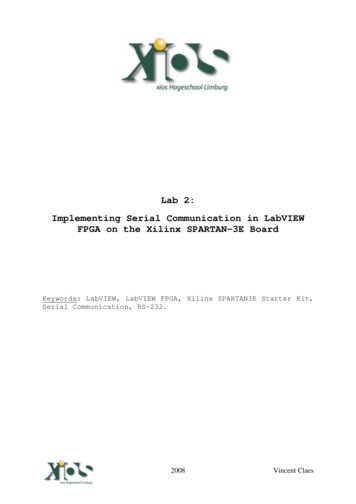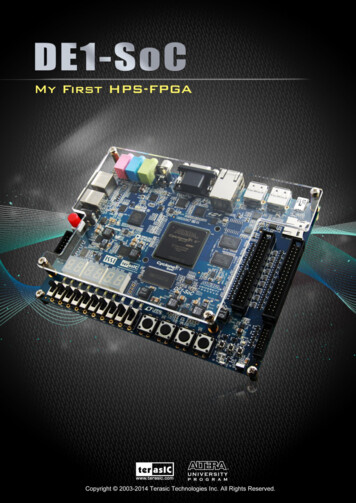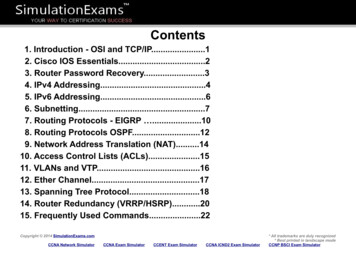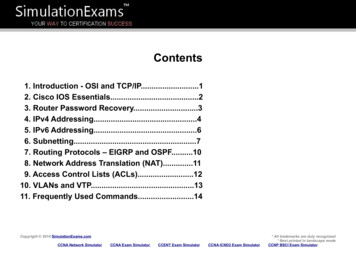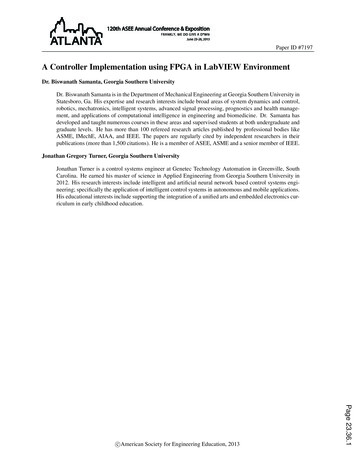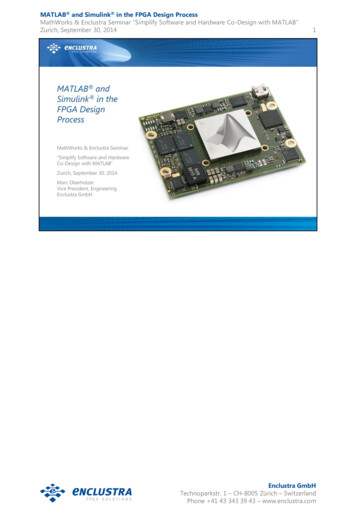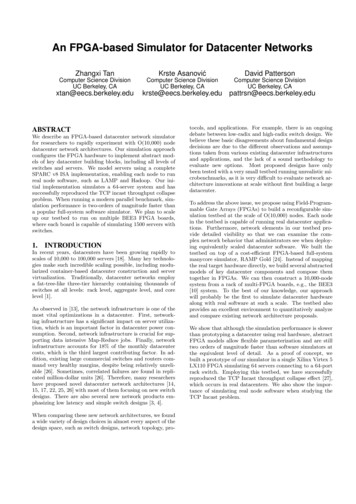
Transcription
An FPGA-based Simulator for Datacenter NetworksZhangxi TanKrste AsanovićDavid PattersonComputer Science DivisionUC Berkeley, CAComputer Science DivisionUC Berkeley, CAComputer Science DivisionUC Berkeley, CAxtan@eecs.berkeley.edukrste@eecs.berkeley.edu pattrsn@eecs.berkeley.eduABSTRACTWe describe an FPGA-based datacenter network simulatorfor researchers to rapidly experiment with O(10,000) nodedatacenter network architectures. Our simulation approachconfigures the FPGA hardware to implement abstract models of key datacenter building blocks, including all levels ofswitches and servers. We model servers using a completeSPARC v8 ISA implementation, enabling each node to runreal node software, such as LAMP and Hadoop. Our initial implementation simulates a 64-server system and hassuccessfully reproduced the TCP incast throughput collapseproblem. When running a modern parallel benchmark, simulation performance is two-orders of magnitude faster thana popular full-system software simulator. We plan to scaleup our testbed to run on multiple BEE3 FPGA boards,where each board is capable of simulating 1500 servers withswitches.1.INTRODUCTIONIn recent years, datacenters have been growing rapidly toscales of 10,000 to 100,000 servers [18]. Many key technologies make such incredible scaling possible, including modularized container-based datacenter construction and servervirtualization. Traditionally, datacenter networks employa fat-tree-like three-tier hierarchy containing thousands ofswitches at all levels: rack level, aggregate level, and corelevel [1].As observed in [13], the network infrastructure is one of themost vital optimizations in a datacenter. First, networking infrastructure has a significant impact on server utilization, which is an important factor in datacenter power consumption. Second, network infrastructure is crucial for supporting data intensive Map-Reduce jobs. Finally, networkinfrastructure accounts for 18% of the monthly datacentercosts, which is the third largest contributing factor. In addition, existing large commercial switches and routers command very healthy margins, despite being relatively unreliable [26]. Sometimes, correlated failures are found in replicated million-dollar units [26]. Therefore, many researchershave proposed novel datacenter network architectures [14,15, 17, 22, 25, 26] with most of them focusing on new switchdesigns. There are also several new network products emphasizing low latency and simple switch designs [3, 4].When comparing these new network architectures, we founda wide variety of design choices in almost every aspect of thedesign space, such as switch designs, network topology, pro-tocols, and applications. For example, there is an ongoingdebate between low-radix and high-radix switch design. Webelieve these basic disagreements about fundamental designdecisions are due to the different observations and assumptions taken from various existing datacenter infrastructuresand applications, and the lack of a sound methodology toevaluate new options. Most proposed designs have onlybeen tested with a very small testbed running unrealistic microbenchmarks, as it is very difficult to evaluate network architecture innovations at scale without first building a largedatacenter.To address the above issue, we propose using Field-Programmable Gate Arrays (FPGAs) to build a reconfigurable simulation testbed at the scale of O(10,000) nodes. Each nodein the testbed is capable of running real datacenter applications. Furthermore, network elements in our testbed provide detailed visibility so that we can examine the complex network behavior that administrators see when deploying equivalently scaled datacenter software. We built thetestbed on top of a cost-efficient FPGA-based full-systemmanycore simulator, RAMP Gold [24]. Instead of mappingthe real target hardware directly, we build several abstractedmodels of key datacenter components and compose themtogether in FPGAs. We can then construct a 10,000-nodesystem from a rack of multi-FPGA boards, e.g., the BEE3[10] system. To the best of our knowledge, our approachwill probably be the first to simulate datacenter hardwarealong with real software at such a scale. The testbed alsoprovides an excellent environment to quantitatively analyzeand compare existing network architecture proposals.We show that although the simulation performance is slowerthan prototyping a datacenter using real hardware, abstractFPGA models allow flexible parameterization and are stilltwo orders of magnitude faster than software simulators atthe equivalent level of detail. As a proof of concept, webuilt a prototype of our simulator in a single Xilinx Virtex 5LX110 FPGA simulating 64 servers connecting to a 64-portrack switch. Employing this testbed, we have successfullyreproduced the TCP Incast throughput collapse effect [27],which occurs in real datacenters. We also show the importance of simulating real node software when studying theTCP Incast problem.
Network ArchitecturePolicy away switching layer [17]DCell [16]Portland (v1) [6]Portland (v2) [22]BCube [15]VL2 [14]Thacker’s container network [26]TestbedClick software routerCommercial hardwareVirtual machine commercial switchVirtual machine NetFPGACommercial hardware NetFPGACommercial hardwarePrototyping with FPGA boardsScaleSingle switch 20 nodes20 switches 16 servers20 switches 16 servers8 switches 16 servers10 servers 10 switches-WorkloadMicrobenchmarkSynthetic workloadMicrobenchmarkSynthetic workloadMicrobenchmarkMicrobenchmark-Table 1: Datacenter network architecture proposals and their evaluationsEVALUATING DATACENTER NETWORKS 2.1We begin by identifying the key issues in evaluating datacenter networks. Several recent novel network architecturesemploy a simple, low-latency, supercomputer-like interconnect. For example, the Sun Infiniband datacenter switch [3]has a 300 ns port-port latency as opposed to the 7–8 µs ofcommon Gigabit Ethernet switches. As a result, evaluatingdatacenter network architectures really requires simulatinga computer system with the following three features.1. Scale: Datacenters contains O(10,000) servers or more.2. Performance: Large datacenter switches have 48/96ports, and are massively parallel. Each port has 1–4 Kflow tables and several input/output packet buffers. Inthe worst case, there are 200 concurrent events everyclock cycle.3. Accuracy: A datacenter network operates at nanosecond time scales. For example, transmitting a 64-bytepacket on a 10 Gbps link takes only 50 ns, which iscomparable to DRAM access time. This precision implies many fine-grained synchronizations during simulation if models are to be accurate.The Potential of FPGA-based SimulationAs the RAMP [28] project observed, FPGAs have becomea promising vehicle for architectural investigation of massively parallel computer systems. We propose building adatacenter simulator based on the RAMP Gold FPGA simulator [24], to model up to O(10,000) nodes and O(1,000)switches running real datacenter software. Figure 1 abstractly compares our RAMP-based approach to four existing approaches in terms of experiment scale and accuracy.100 %PrototypingRAMPSoftware timing simulationAccuracy2.Virtual machine NetFPGAEC2 functional simulation0%Table 1 summarizes evaluation methodologies in recent network design research. Clearly, the biggest issue is evaluationscale. Although a mid-size datacenter contains tens of thousands of servers and thousands of switches, recent evaluations have been limited to relatively tiny testbeds with lessthan 100 servers and 10–20 switches. Small-scale networksare usually quite understandable, but results obtained maynot be predictive of systems deployed at large scale.For workloads, most evaluations run synthetic programs,microbenchmarks, or even pattern generators, while realdatacenter workloads include web search, email, and MapReduce jobs. In large companies, like Google and Microsoft,trace-driven simulation is often used, due to the abundanceof production traces. But production traces are collected onexisting systems with drastically different network architectures. They cannot capture the effects of timing-dependentexecution on a new proposed architecture.Finally, many evaluations make use of existing commercialoff-the-shelf switches. The architectural details of these commercial products are proprietary, with poor documentationof existing structure and little opportunity to change parameters such as link speed and switch buffer configurations,which may have significant impact on fundamental designdecisions.110100100010000Scale (nodes)Figure 1: RAMP vs. Existing EvaluationsPrototyping has the highest accuracy, but it very expensive to scale beyond O(100) nodes. To increase the number of tested end-hosts, many evaluations [22] utilize virtual machines (VMs) along with programmable network devices, such as NetFPGA [21]. However, multiple VMs timemultiplex on a single physical machine and share the sameswitch port resource. Hence, true concurrency and switchtiming is not faithfully modeled. In addition, it is still veryexpensive to reach the scale of O(1,000) in practice.To accurately model architectural details, computer architects often use full-system software timing simulators, forexample M5 [8] and Simics [20]. Programs running on thesesimulators are hundreds of thousands of times slower thanrunning on a real system. To keep simulation time reasonable, such simulators are rarely used to simulate more thana few dozen nodes.Recently, cloud computing platforms such as Amazon EC2offer a pay-per-use service to enable users to share their dat-
acenter infrastructure at an O(1,000) scale. Researchers canrapidly deploy a functional-only testbed for network management and control plane studies. Such services, however,provide almost no visibility into the network and have nomechanism for accurately experimenting with new switcharchitectures.RAMP GOLD FOR DATACENTER SIMULATIONIn this section, we first review the RAMP Gold CPU simulation model before describing how we extend it to modela complete datacenter including switches, and then providepredictions of scaled-up simulator performance.3.1RAMP GoldRAMP Gold is an economical FPGA-based cycle-accuratefull-system architecture simulator that allows rapid earlydesign-space exploration of manycore systems. RAMP Goldemploys many FPGA-friendly optimizations and has highsimulation throughput. RAMP Gold supports the full 32bit SPARC v8 ISA in hardware, including floating-point andprecise exceptions. It also models sufficient hardware to runan operating system including MMUs, timers, and interruptcontrollers. Currently, we can boot the Linux 2.6.21 kerneland a manycore research OS[19].We term the computer system being simulated the target,and the FPGA environment running the simulation the host.RAMP Gold uses the following three key techniques to simulate a large number of cores efficiently:1. Abstracted Models: A full RTL implementation of atarget system ensures precise cycle-accurate timing,but it requires considerable effort to implement thehardware of a full-fledged datacenter in FPGAs. Inaddition, the intended new switch implementations areusually not known during the early design stage. Instead of full RTL, we employ high-level abstract models that greatly reduce both model construction effortand FPGA resource requirements.2. Decoupled functional/timing models RAMP Gold decouples the modeling of target timing and functionality. For example, in server modeling, the functionalmodel is responsible for executing the target softwarecorrectly and maintaining architectural state, whilethe timing model determines how long an instructiontakes to execute in the target machine. Decouplingsimplifies the FPGA mapping of the functional modeland allows complex operations to take multiple FPGAcycles. It also improves modeling flexibility and modelreuse. For instance, we can use the same switch functional model to simulate both 10 Gbps switches and100 Gbps switches, by changing only the timing model.3. Multithreading Since we are simulating a large numberof cores, RAMP Gold applies multithreading to boththe functional and timing models. Instead of replicating hardware models to model multiple instances inthe target, we use multiple hardware model threadsrunning in a single host model to simulate differenttarget cores. Multithreading significantly improves theThe prototype of RAMP Gold runs on a single Xilinx Virtex5 LX110T FPGA, simulating a 64-core multiprocessor target with a detailed memory timing model. We ran six programs from a popular parallel benchmark, PARSEC [7], ona research OS. Figure 2 shows the geometric mean of thesimulation speedup on RAMP Gold compared to a popular software architecture simulator, Simics [20], as we scalethe number of cores and the level of detail. We configurethe software simulator with three timing models of different levels of detail. Under the 64-core configuration withthe most accurate timing model, RAMP Gold is 263x fasterthan Simics. Note that at this accuracy level Simics performance degrades super-linearly with the number of coressimulated: 64 cores is almost 40x slower than 4 cores.300Speedup (Geometric Mean)3.FPGA resource utilization and hides simulation latencies, such as those from host DRAM access and timingmodel synchronization. The timing model correctlymodels the true concurrency in the target, independent of the time-multiplexing effect of multithreadingin the host simulation model.250200150Functional only263Functional cache/memory(g-cache)Functional cache/memory coherency (GEMS)106100695002 6 7153 1048215443634101632Number of Cores64Figure 2: RAMP Gold speedup over Simics runningthe PARSEC benchmark3.2Modeling a Datacenter with RAMP GoldOur datacenter simulator contains two types of models: nodeand switch. The node models a networked server in a datacenter, which talks over some network fabric (e.g. GigabitEthernet) to a switch. We assume each target server executes the SPARC v8 ISA, which is simulated with one hardware thread in RAMP Gold. By default, we assign a simplein-order issue CPU timing model with a fixed CPI for eachtarget server. The target core frequency is adjustable byconfiguring the timing model at runtime, which simulatesscaling of node performance. We can also add more detailedprocessor and memory timing models for points of interest.Similar to the server model, the switch models are alsohost-threaded, with decoupled timing and functional models. Each hardware thread simulates a single target switchport, while the switch packet buffer is modeled using DRAM.The model also supports changing architectural parameters—such as link bandwidth, delays, and switch buffer size—without time-consuming FPGA resynthesis. The current
switch model simulates a simple output-buffered source-routedarchitecture. We plan to add a conventional switch modelsoon. We use a ring to physically connect all switches andnode models on one host FPGA, but can model any arbitrary target topology.Each functional/timing model pipeline supports up to 64hardware threads, simulating 64 target servers. We canalso configure fewer threads per pipeline to improve singlethread performance. To reach O(10,000) scale, we plan toput down multiple threaded RAMP Gold pipelines in a rackof 10 BEE3 boards as shown in Figure 3. Each BEE3 boardhas four Xilinx Virtex-5 LX155T FPGAs connected with a72-bit wide LVDS ring interconnect. Each FPGA supports16 GB of DDR2 memory in two independent channels, resulting in up to 64 GB of memory for the whole board. EachFPGA provides two CX4 ports, which can be used as two10 Gbps Ethernet interfaces to connect multiple boards.(a)(b)Figure 3: a) Architecture of a BEE3 board. b) Arack of six BEE3 boards, each with 4 FPGAs.On each FPGA, we can fit six pipelines to simulate up to 384servers. We then can simulate 1,536 servers on one BEE3board, since there are four FPGAs on each board. Theonboard 64 GB DRAM simulates the target memory, witheach simulated node having a share of 40 MB.We are looking at expanding memory capacity by employing a hybrid memory hierarchy including both DRAM andflash. Using the BEE3 SLC flash DIMM [11], we can build atarget system with a 32 GB DRAM cache and 256 GB flashmemory on every BEE3.a full Linux 2.6 kernel. LAMP (Linux, Apache, Mysql,PHP) and Java support is from the binary packages of Debian Linux. We plan to run Map-Reduce benchmarks fromHadoop [5] as well as three-tiered Web 2.0 benchmarks, e.g.Cloudstone [23]. Since each node is SPARC v8 compatibleand has a full GNU development environment, the platformis capable of running other datacenter research codes compiled from scratch.3.3Predicted Simulator PerformanceOne major datacenter application is running Map-Reducejobs, where each job contains the two types of tasks: maptasks and reduce tasks. According to the production datafrom Facebook and Yahoo datacenters [29], the medium maptask length at Facebook and Yahoo is 19 seconds and 26seconds respectively, while the medium reduce task lengthis 231 seconds and 76 seconds respectively. Moreover, smalland short jobs dominate, while there are more map tasksthan reduce tasks. In reality, most tasks will finish soonerthan medium length tasks.Table 2 shows the simulation time with different numberof hardware threads on RAMP Gold, if we simulate thesemedium length tasks till completion. To predict the MapReduce performance, we use the simulator performance datagathered while running the PARSEC benchmark. Map taskscan be finished in a few hours, while reduce tasks take longer,ranging from a few hours to a few days. Using fewer threadsper pipeline gives better performance at the cost of simulating fewer servers. Note the simulation time in Table 2 isonly for a single task. Multiple tasks can run simultaneously,because the testbed can simulate a large number of servers.The simulation slowdown compared to a real datacenter isroughly around 1,000x under the 64-thread configuration.This is comparable to a software network simulator usedat Google, which has a slowdown of 600 [2] but doesn’tsimulate any node software.Target SystemFacebook (64 threads/pipeline)Yahoo (64 threads/pipeline)Facebook (16 threads/pipeline)Yahoo (16 threads/pipeline)Map Task5 hours7 hours1 hours2 hoursReduce Task64 hours21 hours16 hours5 hoursTable 2: Simulation time of a single median lengthtask on RAMP GoldIn terms of the host memory bandwidth utilization, whenrunning the PARSEC benchmark, one 64-thread pipelineonly uses 15% of the peak bandwidth of a single-channelDDR2 memory controller. Each BEE3 FPGA has two memory channels, so it should have sufficient host memory bandwidth to support six pipelines.In the next section, we present a small case study to showthat simulating the software stack on the server node can bevital for uncovering network problems.In terms of FPGA utilization for networking, the switchmodels consume trivial resources. Our 64-port output-bufferedswitch only takes 300 LUTs on a Xilinx Virtex-5 FPGA.Moreover, novel datacenter switches are much simpler thantraditional designs. Even real prototyping takes only 10%of the resources on a midsize Virtex-5 FPGA [12].As a proof of concept, we use RAMP Gold to study the TCPIncast throughput collapse problem [27]. The TCP Incastproblem refers to the application-level throughput collapsethat occurs as the number of servers sending data to a clientincreases past the ability of an Ethernet switch to bufferpackets. Such a situation is common within a rack, wheremultiple clients connecting to the same switch share a singlestorage server, such as for NFS servers.Each simulated node in our system runs Debian Linux with4.CASE STUDY: REPRODUCING THE TCPINCAST PROBLEM
Node ModelSchedulerProcessor ModelNIC ModelProcessor Timing Modelrx packetRX QueueSwitch Func.Modeldatacontrolpkt outSwitch ModelFMTMSchedulerSwitchModelNIC Func. ModelNICTimingModelProcessor Func. ModelTX Queue32-bit SPARC v8Processor PipelineLoggerpkt inOutputQueueSwitchTimingModelcontrol(64 Nodes à 64 Threads)dataForwardingLogicrx packetNode ModelTMFMNIC and Switch Timing Model ArchitectureI D nterpkt lengthqueue controlMemory(a)(b)-1dly countcountercontrolControlLogic(c)Figure 4: Mapping the TCP Incast problem to RAMP Gold. a) The target is a 64-server datacenter rack.b) High-level RAMP Gold models. c) Detailed RAMP Gold models.Figure 5 shows the RAMP simulation results compared tothose from the real measurements in [9], when varying theTCP retransmission time out (RTO). As seen from the graph,the simulation results differ from the measured data in termsof absolute values. This difference is mainly because commercial switch architectures are proprietary, so that we lackthe information needed to create an accurate model. Nevertheless, the shapes of the throughput curves are similar.This similarity suggests that using an abstract switch modelcan still successfully reproduce the throughput collapse effect and the trend with more senders. Moreover, the original measurement data contained only up to 16 senders dueto the many practical engineering issues of building a largertestbed. In contrast, it is very easy to scale using our RAMPsimulation.In order to show the importance of simulating node software, we replace the RPC-like application sending logic witha simple naı̈ve FSM-based sender to imitate more conventional network evaluations. The FSM-based sender does notsimulate any computation and directly connects to the TCPprotocol stack. Figure 6 shows the receiver throughput ofFSM senders versus normal senders. We configure a 200 msTCP RTO and 256 KB switch port buffer. Illustrated clearlyon the graph, FSM senders cannot reproduce the throughput collapse, as the throughput gradually recovers with more900Mearsured (RTO 40 ms)Throughput at the receiver (Mbps)Figure 4 illustrates the mapping of the TCP Incast problemon our FPGA simulation platform. The target system is a64-node datacenter rack with a single output-buffered layer2 gigabit switch. The node model is simulated with a single64-thread SPARC v8 RAMP Gold pipeline. The NIC andswitch timing models are similar, both computing packetdelays based on the packet length, link speed and queuingstates.800Simulated (RTO 40ms)700Measured (RTO 200ms)Simulated (RTO 200ms)600500400300200100012346810121618Number of Senders2024324048Figure 5: RAMP Gold simulation vs. real measurementFSM senders. The throughput collapse is also not as significant as that of normal senders. In conclusion, the absence ofnode software and application logic in simulation may leadto a very different result.5.CONCLUSION AND FUTURE WORKOur initial results show that simulating datacenter networkarchitecture is not only a networking problem, but also acomputer system problem. Real node software significantlyaffects the simulation results even at the rack level. OurFPGA-based simulation can improve both the scale andthe accuracy of network evaluation. We believe it will bepromising for datacenter-level network experiments, helpingto evaluate novel protocols and software at scale.Our future work primarily involves developing system func-
1000With sending application logic900No sending logic (FSM only)Goodput (Mbps)8007006005004003002001000181216202432Number of SendersFigure 6: Importance of simulating node softwaretionality and scaling the testbed to multiple FPGAs. Wealso plan to use the testbed to quantitatively analyze previously proposed datacenter network architectures runningreal applications.6.ACKNOWLEDGEMENTWe would like to thank Jonathan Ellithorpe for the contribution of modeling TCP Incast and Glen Anderson forhelpful discussion. This research is supported in part bygifts from Sun Microsystems, Google, Microsoft, AmazonWeb Services, Cisco Systems, Cloudera, eBay, Facebook,Fujitsu, Hewlett-Packard, Intel, Network Appliance, SAP,VMWare and Yahoo! and by matching funds from the Stateof California’s MICRO program (grants 06-152, 07-010, 06148, 07-012, 06-146, 07-009, 06-147, 07-013, 06-149, 06-150,and 07-008), the National Science Foundation (grant #CNS0509559), and the University of California Industry/UniversityCooperative Research Program (UC Discovery) grant COM0710240.7.REFERENCES[1] Cisco data center: Load balancing data center services, 2004.[2] Glen Anderson, private communications, 2009.[3] Sun Datacenter InfiniBand Switch and.jsp,2009.[4] Switching Architectures for Cloud Network Architecture wp.pdf,2009.[5] Hadoop, http://hadoop.apache.org/, 2010.[6] M. Al-Fares, A. Loukissas, and A. Vahdat. A scalable,commodity data center network architecture. In SIGCOMM’08: Proceedings of the ACM SIGCOMM 2008 conference onData communication, pages 63–74, New York, NY, USA, 2008.ACM.[7] C. Bienia et al. The PARSEC Benchmark Suite:Characterization and Architectural Implications. In PACT ’08,pages 72–81, New York, NY, USA, 2008. ACM.[8] N. L. Binkert, R. G. Dreslinski, L. R. Hsu, K. T. Lim, A. G.Saidi, and S. K. Reinhardt. The M5 simulator: Modelingnetworked systems. IEEE Micro, 26(4):52–60, 2006.[9] Y. Chen, R. Griffith, J. Liu, R. H. Katz, and A. D. Joseph.Understanding TCP incast throughput collapse in datacenternetworks. In WREN ’09: Proceedings of the 1st ACMworkshop on Research on enterprise networking, pages 73–82,New York, NY, USA, 2009. ACM.[10] J. Davis, C. Thacker, and C. Chang. BEE3: RevitalizingComputer Architecture Research. Technical ReportMSR-TR-2009-45, Microsoft Research, Apr 2009.[11] J. D. Davis and L. Zhang. FRP: a Nonvolatile MemoryResearch Platform Targeting NAND Flash. In The FirstWorkshop on Integrating Solid-state Memory into the StorageHierarchy, Held in Conjunction with ASPLOS 2009, March2009.[12] N. Farrington, E. Rubow, and A. Vahdat. Data center switcharchitecture in the age of merchant silicon. In HOTI ’09:Proceedings of the 2009 17th IEEE Symposium on HighPerformance Interconnects, pages 93–102, Washington, DC,USA, 2009. IEEE Computer Society.[13] A. Greenberg, J. Hamilton, D. A. Maltz, and P. Patel. The costof a cloud: research problems in data center networks.SIGCOMM Comput. Commun. Rev., 39(1):68–73, 2009.[14] A. Greenberg, J. R. Hamilton, N. Jain, S. Kandula, C. Kim,P. Lahiri, D. A. Maltz, P. Patel, and S. Sengupta. Vl2: ascalable and flexible data center network. In SIGCOMM ’09:Proceedings of the ACM SIGCOMM 2009 conference on Datacommunication, pages 51–62, New York, NY, USA, 2009. ACM.[15] C. Guo, G. Lu, D. Li, H. Wu, X. Zhang, Y. Shi, C. Tian,Y. Zhang, and S. Lu. Bcube: a high performance, server-centricnetwork architecture for modular data centers. In SIGCOMM’09: Proceedings of the ACM SIGCOMM 2009 conference onData communication, pages 63–74, New York, NY, USA, 2009.ACM.[16] C. Guo, H. Wu, K. Tan, L. Shi, Y. Zhang, and S. Lu. Dcell: ascalable and fault-tolerant network structure for data centers.In SIGCOMM ’08: Proceedings of the ACM SIGCOMM 2008conference on Data communication, pages 75–86, New York,NY, USA, 2008. ACM.[17] D. A. Joseph, A. Tavakoli, and I. Stoica. A policy-awareswitching layer for data centers. In SIGCOMM ’08:Proceedings of the ACM SIGCOMM 2008 conference on Datacommunication, pages 51–62, New York, NY, USA, 2008. ACM.[18] R. Katz. Tech titans building boom: The architecture ofinternet datacenters. IEEE Spectrum, February 2009.[19] R. Liu et al. Tessellation: Space-Time partitioning in amanycore client OS. In HotPar09, Berkeley, CA, 03/2009 2009.[20] P. S. Magnusson et al. Simics: A Full System SimulationPlatform. IEEE Computer, 35, 2002.[21] J. Naous, G. Gibb, S. Bolouki, and N. McKeown. NetFPGA:Reusable router architecture for experimental research. InPRESTO ’08: Proceedings of the ACM workshop onProgrammable routers for extensible services of tomorrow,pages 1–7, New York, NY, USA, 2008. ACM.[22] R. Niranjan Mysore, A. Pamboris, N. Farrington, N. Huang,P. Miri, S. Radhakrishnan, V. Subramanya, and A. Vahdat.Portland: a scalable fault-tolerant layer 2 data center networkfabric. In SIGCOMM ’09: Proceedings of the ACMSIGCOMM 2009 conference on Data communication, pages39–50, New York, NY, USA, 2009. ACM.[23] W. Sobel, S. Subramanyam, A. Sucharitakul, J. Nguyen,H. Wong, A. Klepchukov, S. Patil, A. Fox, and D. Patterson.Cloudstone: Multi-platform, multi-language benchmark andmeasurement tools for web 2.0. In CCA ’08: Proceedings ofthe 2008 Cloud Computing and Its Applications, Chicago, IL,USA, 2008.[24] Z. Tan, A. Waterman, R. Avizienis, Y. Lee, D. Patterson, andK. Asanović. Ramp Gold: An FPGA-based architecturesimulator for multiprocessors. In 4th Workshop onArchitectural Research Prototyping (WARP-2009), at 36thInternational Symposium on Computer Architecture(ISCA-36), 2009.[25] A. Tavakoli, M. Casado, T. Koponen, and S. Shenker. ApplyingNOX to the datacenter. In HotNets, 2009.[26] C. Thacker. Rethinking data centers. October 2007.[27] V. Vasudevan, A. Phanishayee, H. Shah, E. Krevat, D. G.Andersen, G. R. Ganger, G. A. Gibson, and B. Mueller. Safeand effective fine-grained TCP retransmissions for datacentercommunication. In SIGCOMM ’09: Proceedings of the ACMSIGCOMM 2009 conference on Data communication, pages303–314, New York, NY, USA, 2009. ACM.[28] J. Wawrzynek et al. RAMP: Research Accelerator for MultipleProcessors. IEEE Micro, 27(2):46–57, 2007.[29] M. Zaharia, D. Borthakur, J. Sen Sarma, K. Elmeleegy,S. Shenker, and I. Stoica. Job scheduling for multi-usermapreduce clusters. Technical Report UCB/EECS-2009-55,EECS Department, University of California, Berkeley, Apr2009.
nect. For example, the Sun Infiniband datacenter switch [3] has a 300ns port-port latency as opposed to the 7-8µs of common Gigabit Ethernet switches. As a result, evaluating datacenter network architectures really requires simulating a computer system with the following three features. 1. Scale: Datacenters contains O(10,000) servers or .

